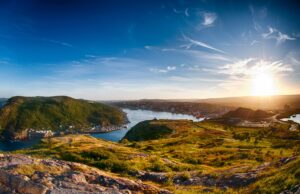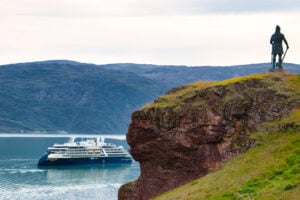
Travel
Exploring Newfoundland with Adventure Canada
Immerse yourself in Viking archaeology and Basque whaling history while taking in Newfoundland’s scenic coastline and incredible geology
- 1201 words
- 5 minutes
This article is over 5 years old and may contain outdated information.
Travel

Rising, diving, blowing, breeching – an estimated forty humpback whales were in a feeding frenzy, ploughing through shoals of capelin as the tiny silver fish headed for the Newfoundland shore. And my husband and I were only a hundred metres away, in a zodiac with eight MEC-clad strangers and a guide who kept repeating, “I’ve never seen anything like this.” Nobody else on our tour had, either—a once in a lifetime experience.
This was the first of many “Wow!” sights on our Adventure Canada cruise up the coast of Labrador and across to Greenland. After a few days we were almost blasé about the icebergs, with their luminous majesty, which glided past the Ocean Endeavour. (Although, I constantly found myself thinking, “Grimm Fairy Stories castle? No. Henry Moore sculpture? No. Ice cream cake?”)
By the time we reached Labrador’s Torngat Mountains and Greenland’s glaciers, I’d run out of gushing superlatives. There was more to come. Polar bears: tick. Incredible hikes through fields of fireweed, arnica and cotton grass: tick. Muskox: tick. Reindeer: tick. A brief stroll on Greenland’s rapidly shrinking icecap: tick.
Two particular experiences stand out. The first was my introduction to the story of Moravian missionaries on the Labrador coast. As I learned from Dr. Tom Gordon, an ethnomusicologist from Memorial University and our onboard expert on the subject, the first of these German Protestants arrived at a rugged, fog-shrouded inlet as early as 1751.
By 1782, the Moravians had established three settlements and begun the process of converting the local Inuit. There would eventually be seven settlements.
Missionaries have a bad name these days; they distorted indigenous cultures by imposing their European beliefs and behaviours (plus their diseases and trade demands.) Yet for 200 years, the Moravians brought more than their faith to this wild and fierce landscape. They made the first effort to translate the Inuit spoken language into written syllabics, and by the mid-nineteenth century, every Inuit who wintered at one of the missions was literate, and many were skilled musicians.
The Moravians are long gone now, but many of their bleached and weathered churches and mission houses have survived the subarctic winters and Atlantic gales. Cameras clicking, we roamed through Hopedale, Ramah and Hebron. There is a forlorn dignity to these battered old wooden buildings, perched on narrow meadows between crashing surf and steep hills.
Today, the Labrador Inuit have their own autonomous government, Nunatsiavut. Their uber-modern Assembly building, in the tiny village of Hopedale, made a triumphant contrast to the faded Moravian buildings.
My second startling experience was a polar dip. If you had asked me as we set off whether I would jump into a Greenland fjord (water temperature 2C) full of small icebergs calving from a glacier, I’d have looked at you in horror. But twelve days into the voyage, I was giddy with the exhilaration of midnight sun and northern waters. So alongside Lisa Moore, the wonderful Newfoundland novelist who was another staff expert onboard, I took a flying leap off the gangplank. It was worth it for the bragging rights.
Are you passionate about Canadian geography?
You can support Canadian Geographic in 3 ways:

Travel
Immerse yourself in Viking archaeology and Basque whaling history while taking in Newfoundland’s scenic coastline and incredible geology

Travel
Seeing iconic landscapes before they fade away may be accelerating their demise. Can we square the circle on making these trips sustainable?

People & Culture
A moratorium on cod fishing that was supposed to last two years has now lasted 30. What will it take to rebuild cod stocks — and a way of life?

People & Culture
Crowdfunded by Fellows of The Royal Canadian Geographical Society, the new teaching tool is the first provincial map of its kind